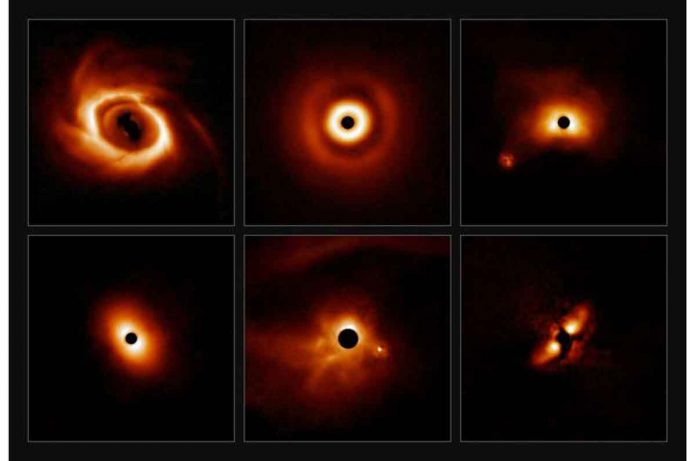This mosaic of dusty, swirling discs depicts a selection of images obtained from the International Gemini Observatory, a program of the National Science Foundation’s NOIRLab, as part of an unprecedented survey of 44 young massive stars. An international team investigated planet formation using Gemini South in Chile, discovering a potential young Jupiter-mass planet and confirming the existence of two brown dwarfs. The images will be shown in sessions at today’s 240th American Astronomical Society meeting.
This striking image was captured by astronomers using Chile’s Gemini South telescope as part of a large survey of 44 young, massive stars by the Gemini Planet Imager (GPI) instrument, which imaged their dusty planet-forming disks—likely to become new solar systems—in near-infrared light. According to the survey, discs circling stars up to three times the mass of the Sun have rings, whereas discs circling stars more massive than three solar masses do not. This implies that more massive stars may form planets in a slightly different way.
Planets form in discs of gas and dust that encircle young stars only a few million years old, and GPI is one of only a few instruments capable of resolving these discs in the world. Previous observations have shown that rings of large and small dust grains, as well as gas, are frequently observed in these discs. Exactly what creates these rings is uncertain, but they have been attributed to newborn planets interacting with the disc.
Gemini-LIGHTS (Gemini-Large Imaging with GPI Herbig/T-Tauri Survey) astronomers attempted to answer some of these questions by producing high-resolution images of the discs surrounding a sample of 44 stars.

“We want to answer the fundamental question of how planets form,” said Evan Rich, a postdoctoral researcher at the University of Michigan and lead author of a new paper describing the findings published in The Astronomical Journal. The Gemini-LIGHTS survey, he says, “focuses on stars that are more massive than the Sun to investigate the influence that a parent star’s mass may have on the planet-formation process.”
Gemini South photographed the discs in near-infrared and polarised light. It discovered discs around 80 percent of the 44 stars studied, as well as one new candidate planet (circa V1295 Aquilae) and three brown dwarfs. Two of the brown dwarfs (circling the stars V921 Sco and HD 158643) were previously identified as candidates and have now been confirmed by these observations; the third brown dwarf, around the star HD 101412, is a new candidate.
The key finding of the survey, however, is that the discs appear to behave differently depending on the mass of the star they are circling. “Systems with small dust-grain rings are only found around stars that are less than three times the mass of the Sun,” Rich explained. “This is significant because forming planets are thought to be responsible for the ringed structure, and our findings suggest that the planet formation process may differ for stars with masses greater than three times that of the Sun.”
This information will be presented in a press conference and oral presentation today at the 240th American Astronomical Society Meeting. This research was presented in a paper that will be published in The Astronomical Journal.

